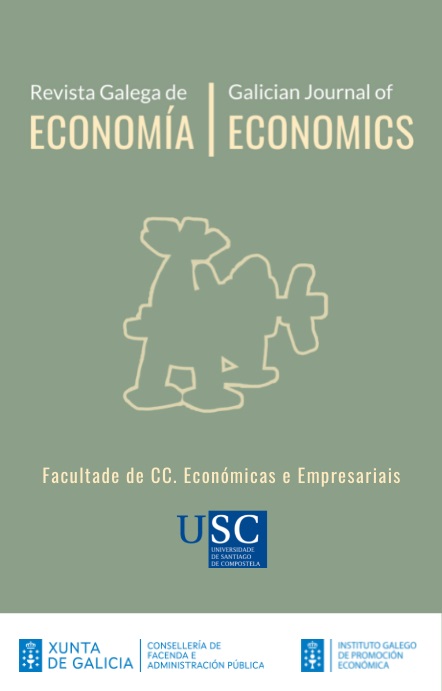O poder dos construtores de lugares e dos comerciantes: o Papa e os artigos marianos na economía política da peregrinación
Contido principal do artigo
Resumo
A partir dos estudos de campo sobre o nivel micro dos artigos que os xestores dos lugares visitados e os comerciantes exhiben nos sitios sagrados, proponse un argumento sobre o lado da oferta da economía política da peregrinación. Os xestores dos lugares visitados e os comerciantes baséanse nas tradicións establecidas polos peregrinos, pero difiren no tocante ás innovacións. Os xestores de lugares visitados son os seus directores e invisten en innovacións para asegurar o rendemento do lugar a longo prazo. Os comerciantes confían nas decisións de compra a curto prazo dos peregrinos. Prefiren os produtos probados e buscan novidades que se axusten ao patrón de éxito. Mentres que a resistencia dos xestores dos lugares visitados demostra o poder do lado da oferta, a cautela dos comerciantes insinúa os límites. Roma durante o Xubileu da Misericordia de Francisco e mais o santuario mariano bávaro de Altötting nos anos posteriores á dimisión do Papa Bieito XVI son os casos de estudo para ilustrar estas afirmacións na perspectiva da peregrinación mariana e papal.
Palabras chave
Detalles do artigo
Citas
Anderson, B. (2016). Imagined communities: Reflections on the origin and spread of nationalism. (2nd revised edition). London, UK/New York, NY: Verso.
Barbato, M. P. (2020a). Geopolitics of Papal Traveling: (Re)constructing a catholic landscape in Europe. Religions, 11(10), 525. DOI: https://doi.org/10.3390/rel11100525
Barbato, M. P. (2020b). The holy see, public spheres and postsecular transformations of international relations. An introduction. In M. P. Barbato (Ed.), The Pope, the public, and international relations postsecular transformations (pp. 1-22). Chamm, Switzerland: Palgrave Macmillan. DOI: https://doi.org/10.1007/978-3-030-46107-2_1
Coleman, S., & Eade, J. (2018a). Pilgrimage and political economy: Introduction to a research agenda. In S. Coleman & J. Eade (Eds.), Pilgrimage and political economy: Translating the sacred (pp. 1-20). New York, NY: Berghahn Books.
Coleman, S., & Eade, J. (Eds.). (2018b). Pilgrimage and political economy: Translating the sacred. New York, NY: Berghahn Books. DOI: https://doi.org/10.1080/09637494.2021.1892993
Davies, P., Howard, D., & Pullan, W. (Eds.). (2013). Architecture and pilgrimage, 1000-1500: Southern Europe and Beyond. Burlington, VT: Ashgate.
Eade, J., & Katić, M. (2014a). Introduction: Crossing the border. In J. Eade & M. Katić (Eds.), Pilgrimage, politics and place-making in Eastern Europe: Crossing the borders. Farnham, UK/Burlington, VT: Ashgate.
Eade, J., & Katić, M. (Eds.). (2014b). Pilgrimage, politics and place-making in Eastern Europe: Crossing the borders. Farnham, UK/Burlington, VT: Ashgate.
Eade, J., Sallnow, M. J. (2000). Introduction. In J. Eade & M. J. Sallnow (Eds.), Contesting the sacret: The anthropology of pilgrimage (pp. 1-29). Urbana and Chicago, IL: University of Illinois Press.
Geertz, C. (1973). The interpretations of cultures. New York, NY: Basic Books.
Hermkens, A.-K., Jansen, W., & Notermans, C. (2009a). Introduction: The power of Marian pilgrimage. In A.-K. Hermkens, W. Jansen & C. Notermans (Eds.), Moved by Mary: The power of pilgrimage in the modern world (pp. 1-13). Farnham, UK/Burlington, VT: Ashgate.
Hermkens, A.-K., Jansen, W., & Notermans, C. (Eds.). (2009b). Moved by Mary: The power of pilgrimage in the modern world (pp. 1-13). Farnham, UK/Burlington, VT: Ashgate.
Imkamp, W. (2014). Pastorale Devotionsästhetik. Pilgern Auf Der via Pulchritudinis. In G. Riedl, H. Heinrich & B. Meier (Eds.), Neue Evangelisierung – Kirche konkret (pp. 82-107). Paderborn, Germany: Verlag Ferdinand Schöningh.
John Paul II. (1981). Angelus. Solennità dell’Immacolata. 8 dicembre 1981. Giovanni Paolo II. Retrieved from: https://www.vatican.va/content/john-paul-ii/it/angelus/1981/documents/hf_jp-ii_ang_19811208.html
Katić, M. (2014). From the chapel on the hill to national shrine: Creating a pilgrimage 'home' for Bosnian Croats. In J. Eade & M. Katić (Eds.), Pilgrimage, politics and place-making in Eastern Europe: Crossing the borders (pp. 15-36). Farnham, Uk/Burlington, VT: Ashgate.
Kaufman, S. K. (2005). Consuming visions: Mass culture and the Lourdes shrine. Ithaca, NY: Cornell University Press. DOI: https://doi.org/10.7591/9781501727351
Kinnard, J. N. (2014). Places in motion: The fluid identities of temples, images, and pilgrims. New York, NY: Oxford University Press. DOI: https://doi.org/10.1093/acprof:oso/9780199359653.003.0001
Lois González, R. C., & Castro-Fernández, B. (2020). Spectacle and power: Sites and spaces of Papal visits. In M. Barbato (Ed.), The Pope, the public, and international relations: Postsecular transformations (pp. 133-150). Cham, Switzerland: Palgrave Macmillan. DOI: https://doi.org/10.1007/978-3-030-46107-2
Maddrell, A., della Dora, V., Scafi, A., & Walton, H. (2018). Christian pilgrimage, landscape and heritage: Journeying to the sacred. New York, NY: Routledge. DOI: https://doi.org/10.1080/14616688.2020.1740937
Paul VI. (1975). Discorso di Paolo VI ai Congressi Mariologico e Mariano, venerdì, 16 maggio 1975. Retrieved from: https://www.vatican.va/content/paul-vi/it/speeches/1975/documents/hf_p-vi_spe_19750516_congresso-mariologico.html
Plate, S. B. (Ed.). (2015). Key terms in material religion. New York, NY: Bloomsbury Academic.
Reader, I. (2014). Pilgrimage in the marketplace. New York, NY: Routledge.
Rousseau, K. (2016). Pilgrimage, spatial interaction, and the memory at three Marian sites. Denver, CO: University of Denver.
Stark, R., & Bainbridge, W. S. (1996). A theory of religion. New Brunswick, NJ: Rutgers University Press.
Turner, V. W. (1995). The ritual process: Structure and anti-structure. New York, NY: Aldine de Gruyter.
Turner, V. W., Turner, E. L. B. (2011). Image and pilgrimage in christian culture. New York, NY: Columbia University Press.
Vallely, P. (Ed.). (2013). Pope Francis: Untying the knots. London, UK: Bloomsbury Academic.
Willmerdinger, G., & Stummer, J. (2008). Shrines of Europe die Marienheiligtümer Europas ; [Altötting - Tschenstochau - Fatima - Loreto - Lourdes – Mariazell]. München, Germany: Oberbayern-Presse.
Zimdars-Swartz, S. L. (2014). Encountering Mary: From La Salette to Medjugorje. Princeton, NJ: Princeton University Press.







